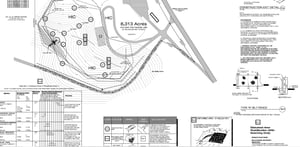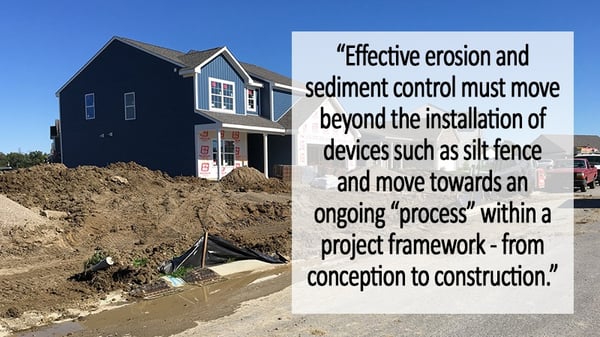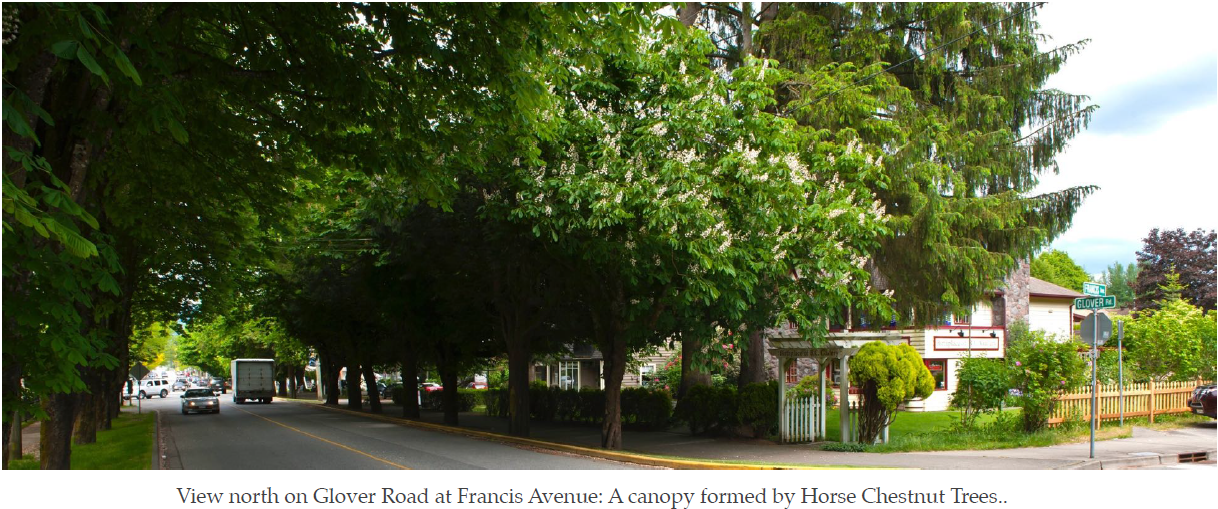Urban Construction - Controlling Erosion & Sediment
Soil erosion occurs naturally as a result of the action of rain and the power of water and wind to detach soil and transport particles across the surface. The extent of erosion losses will depend on climate, topography, and the ability of soils to resist detachment and infiltrate water, but a good vegetative cover can largely offset the effect of these factors. Plant cover and natural vegetative residue protect the soil from the impact of raindrops, slows runoff and enhances infiltration of water.
 Rapid urban expansion and associated construction activities are a significant source of stress to the natural environment. Construction activities accelerate natural processes of erosion and sedimentation as vegetation is stripped away and soils are left exposed; natural drainage pathways are altered and stable topsoil aggregates are stripped away as part of the grading process. As a result, stormwater runoff from these sites contains high levels of sediment and associated contaminants. If left uncontrolled, erosion of exposed soils can cause local air quality problems, degradation of aquatic habitats, and damage to downstream recreational areas and infrastructure. Implementation of adequate water quality controls at construction sites is crucial to ensuring downstream receiving waters and aquatic habitats are adequately protected.
Rapid urban expansion and associated construction activities are a significant source of stress to the natural environment. Construction activities accelerate natural processes of erosion and sedimentation as vegetation is stripped away and soils are left exposed; natural drainage pathways are altered and stable topsoil aggregates are stripped away as part of the grading process. As a result, stormwater runoff from these sites contains high levels of sediment and associated contaminants. If left uncontrolled, erosion of exposed soils can cause local air quality problems, degradation of aquatic habitats, and damage to downstream recreational areas and infrastructure. Implementation of adequate water quality controls at construction sites is crucial to ensuring downstream receiving waters and aquatic habitats are adequately protected.
The deleterious effects of excess sediment discharges on aquatic life are well documented. Effects on fish may include impairment to respiratory functions, lower tolerance to toxicants or disease, increased physiological stress, decreased reproductive success, and reduced vision, which inhibits their ability to find food. Migrating fish will avoid rivers with high suspended solids concentrations. Excess sediment discharge to downstream watercourses may also have degradation on water quality, increase stream flooding, elevation levels of in-stream erosion influencing the geomorphic stability/instability of the watercourse channel, and reduce navigation in waterways.

Sediment control measures have been required on construction sites for decades. However, even on sites where recommended practices are applied, sediment continues to be discharged at concentrations above those required to protect aquatic life. In one Toronto area study, monitoring of a channel reach upstream and downstream of a construction site showed an average increase in suspended solids concentration of 500%. This increase in stream sediment concentration occurred even though runoff volumes from the construction site comprised less than 25% of total stream flow and sediment control practices were in compliance with interim guidelines.
Numerous guideline documents have been prepared since the 1980s, which emphasized the importance of protecting the natural environment during construction activities. While these are notable improvements that have effectively improved mitigation of environmental disturbances in construction projects, there have also been many examples of where adequate protection measures for the natural environment have not been diligently applied.
Field surveys of erosion and sediment control practices on construction sites have revealed a number of serious deficiencies in current planning and implementation. These include:
- The absence of development phasing in which only a portion of the construction site is cleared and graded at any one time;
- Long time lags between soil disturbance and soil stabilization;
- Unnecessary clearing of environmental sensitive areas, such as stream riparian buffers, steep slopes, wetlands and seeps;
- Inadequate maintenance of sediment controls (e.g. sediment ponds, etc.); and,
- Poor field inspection practices and ESC plan enforcement.
This Guideline is intended to help improve the practice of erosion and sediment control, and ensure that a well-defined process is in place to ensure ESC plans are prepared, implemented and enforced.
.jpg?width=300&name=construction%20sediment%20control%20(2).jpg) The pressures of urban development have large scale impacts to the natural environment and in particular aquatic resources and their natural corridors. Changes to the land use can decrease permeability, increase fine sediment inputs, impact on water quality and increase runoff. These changes create an unbalance in the natural processes and lead to increased flood events, reduce base flows, decrease habitat diversity and channel erosion. Sedimentation from construction activities is a major contributor to these problems. This added sediment contributes to the destabilization of watercourses that not only has extreme ecological costs, but results in the loss of property, costly infrastructure repairs and stabilization efforts that could take a lifetime to complete. It is everyone’s responsibility to prevent construction related sediment from impacting aquatic resources and other natural features.
The pressures of urban development have large scale impacts to the natural environment and in particular aquatic resources and their natural corridors. Changes to the land use can decrease permeability, increase fine sediment inputs, impact on water quality and increase runoff. These changes create an unbalance in the natural processes and lead to increased flood events, reduce base flows, decrease habitat diversity and channel erosion. Sedimentation from construction activities is a major contributor to these problems. This added sediment contributes to the destabilization of watercourses that not only has extreme ecological costs, but results in the loss of property, costly infrastructure repairs and stabilization efforts that could take a lifetime to complete. It is everyone’s responsibility to prevent construction related sediment from impacting aquatic resources and other natural features.
An undermined or breached silt fence provides an obvious example of containment problems, but unfortunately, the signs and symptoms revealing more dire threats to sensitive environmental features remain hidden until the project is well underway or complete. For this reason, all the parties involved, from the earliest assessment stages of a project right through to implementation, must have regard for the natural environment associated with the project. This common understanding of the environmental sensitivities will allow for the collaboration of individuals representing a diverse range of disciplines throughout the lifespan of a project. The outcome of this unified effort will be an effective implementation of erosion and sediment control strategies, an appreciable improvement in the prevention and mitigation of environmental impacts, compliance with regulatory responsibilities and more effective management of the fiscal aspects of the project.

It is important to consider that effective erosion and sediment control must move beyond the installation of devices such as silt fence and move towards an ongoing “process” within a project framework - from conception to construction. This would provide a framework where environmental issues are routinely discussed and addressed through specific design elements, influence on project schedule or navigating constructability issues. Shifting to a dynamic and integrated process of erosion, sediment control and environmental awareness will contribute greatly to eliminating oversights in the protection measures prescribed for the project and ensure adequate and responsible protection of the natural environment. The timely consideration of the environmental constraints will also significantly reduce delays in approval acquisitions, potential for severe environmental mishaps, costly restoration, along with impacts to project schedules and missed deadlines/delivery dates.
The best starting point for any project relating to urban development is to have a clear understanding of the proposed undertaking and the results of the undertaking on the surrounding environment. Such assessments require significant detail within the project to clarify the extent of sensitivities and resulting environmental constraints. Open discussions between the proponent and/or the proponent’s agents and the regulatory agencies should be encouraged to ensure that the proposal will satisfy the approval requirements. This is encouraged for all urban development projects, but should be applied particularly to large-scale, complex projects and those situated in sensitive natural areas.
.jpg?width=400&name=construction%20sediment%20control%20(1).jpg)
Construction projects vary widely in type, size and complexity. There is usually a variety of professionals contributing at any stage of the project. Environmental studies will form the base of information that can influence the development of the design. Skilled and experienced professionals in each represented discipline will consider the implications and offer solutions that ultimately result in an environmentally sound and operational design. It is important to note that the professionals included in the design team often have regulatory agency and/or third party counterparts, who review the proposed undertaking in light of applicable governing legislation and specific interests. These perspectives and design elements are united by the project engineers, who integrate them into the final detail design and approval submission. Included as an integral part of the submission is an erosion and sediment control plan that has been developed by combining environmental site conditions with all the construction elements required for an undertaking. The end product is an effective erosion and sediment control strategy.
exerts from Erosion & Sediment Control Guideline for Urban Construction



